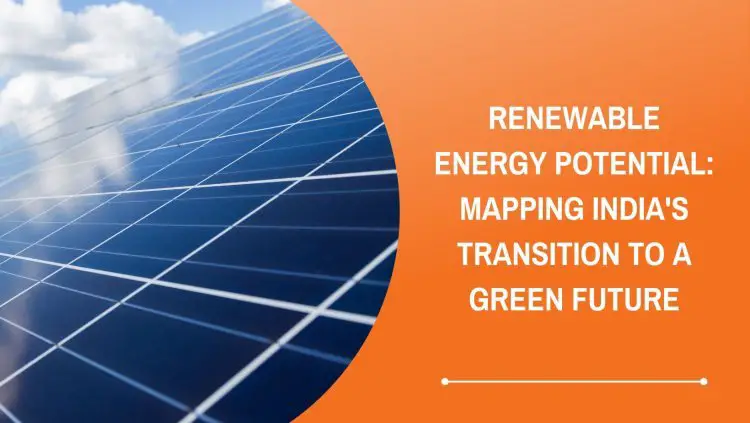Renewable Energy Potential: Mapping India's Transition to a Green Future
India stands at a crucial juncture in its quest for sustainable development, marked by a significant shift towards renewable energy sources.

India stands at a crucial juncture in its quest for sustainable development, marked by a significant shift towards renewable energy sources. With the pressing need to mitigate climate change and reduce dependence on fossil fuels, the country is increasingly turning to solar energy and other renewables to power its future. This transition is not merely about embracing cleaner sources of energy; it represents a fundamental restructuring of India's energy landscape, with far-reaching implications for its economy, environment, and society.
Embracing Solar Power:
Solar energy has emerged as a cornerstone of India's renewable energy strategy. Blessed with abundant sunlight throughout the year, India possesses immense solar energy potential, making it an ideal candidate for large-scale solar power generation. The government's ambitious targets, such as achieving 100 GW of solar capacity by 2022 and 450 GW by 2030, underscore its commitment to harnessing this abundant resource.
One of the most notable successes in India's solar journey has been the dramatic reduction in solar tariffs. Through competitive bidding processes and technological advancements, the cost of solar power has plummeted, making it increasingly competitive with conventional sources of energy. This cost competitiveness has not only accelerated the deployment of solar projects but has also made solar energy accessible to a wider range of consumers, including industries, commercial establishments, and households.
Beyond Solar: Diversifying the Renewable Portfolio:
While solar energy dominates discussions around India's renewable energy transition, other sources such as wind, hydro, biomass, and geothermal also play crucial roles. Wind energy, in particular, has witnessed significant growth, with India emerging as one of the world's top wind energy producers. Similarly, the untapped potential of hydroelectric power, particularly in regions like the Himalayas, presents opportunities for further expansion.
Moreover, advancements in technology and innovation are opening up new frontiers in renewable energy. From offshore wind farms to floating solar installations and innovations in energy storage, these developments are enriching India's renewable energy portfolio and enhancing its resilience against variability in weather conditions.
Policy Support and Regulatory Framework:
The success of India's energy transition hinges upon a conducive policy environment and robust regulatory frameworks. The government's flagship initiatives, such as the National Solar Mission, the Green Energy Corridor Project, and various state-level policies, provide the necessary impetus for renewable energy deployment. Furthermore, measures such as renewable purchase obligations, net metering, and fiscal incentives are incentivizing investments in clean energy projects.
However, challenges persist, including land acquisition issues, grid integration constraints, and financing hurdles. Addressing these challenges requires a coordinated effort from policymakers, industry stakeholders, and civil society to streamline processes, enhance grid infrastructure, and mobilize investments.
Socioeconomic Impacts and Opportunities:
India's transition to renewable energy is not only about reducing carbon emissions; it also holds immense socioeconomic potential. The renewable energy sector is a significant driver of job creation, offering employment opportunities across the value chain, from manufacturing and installation to operations and maintenance. Moreover, decentralized renewable energy solutions have the potential to empower rural communities by providing access to clean, reliable, and affordable energy.
Furthermore, by reducing dependence on imported fossil fuels, India's renewable energy push enhances energy security and reduces the nation's vulnerability to global energy price fluctuations. This, in turn, strengthens India's economic resilience and fosters sustainable growth.
Conclusion:
India's journey towards a green future powered by renewable energy is both promising and challenging. While significant progress has been made, much work lies ahead to realize the full potential of renewables and achieve the nation's energy transition goals. Collaboration among government, industry, academia, and civil society will be key to overcoming barriers, driving innovation, and accelerating the adoption of clean energy technologies. With steadfast commitment and collective action, India can pave the way for a sustainable, inclusive, and prosperous future powered by renewable energy.
What's Your Reaction?

































